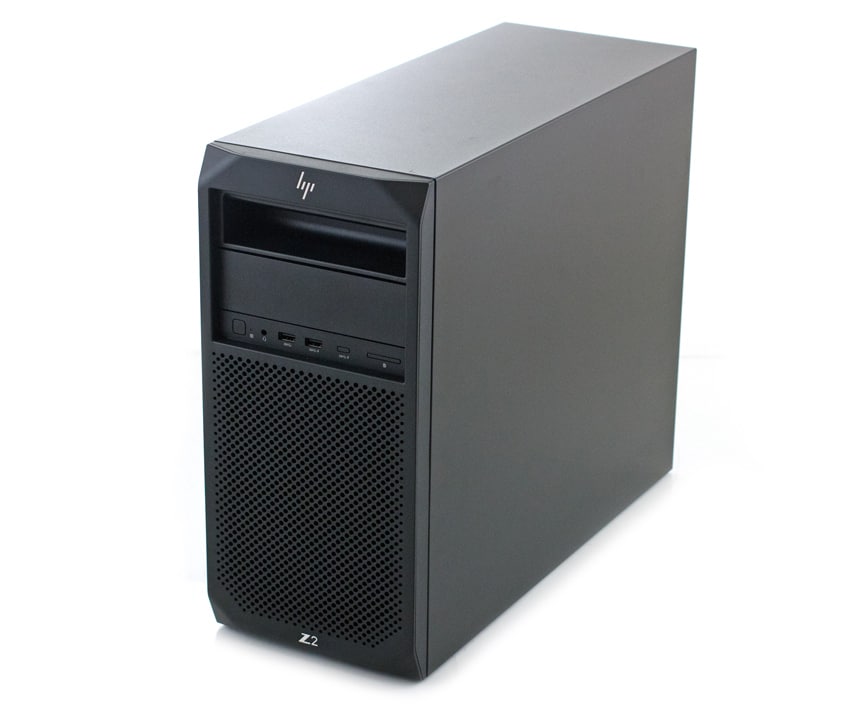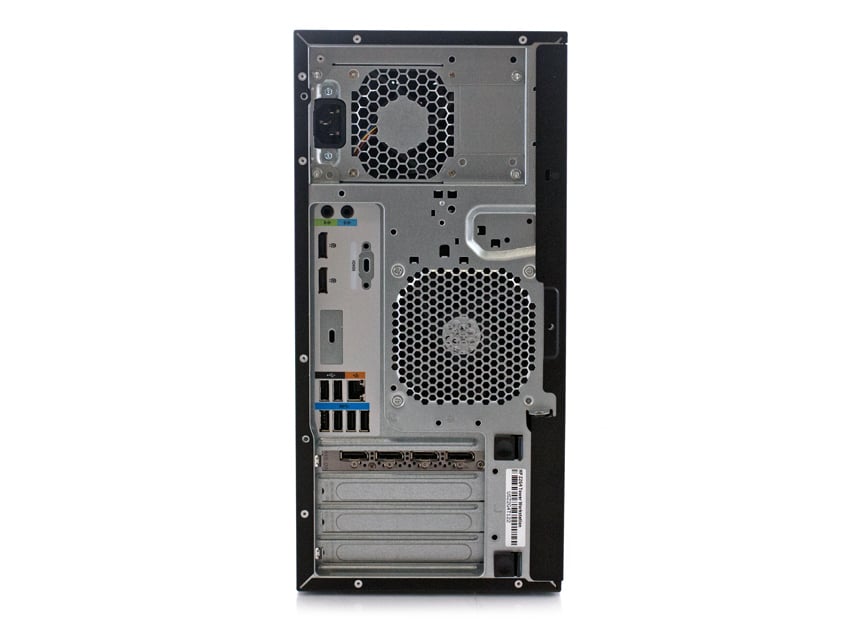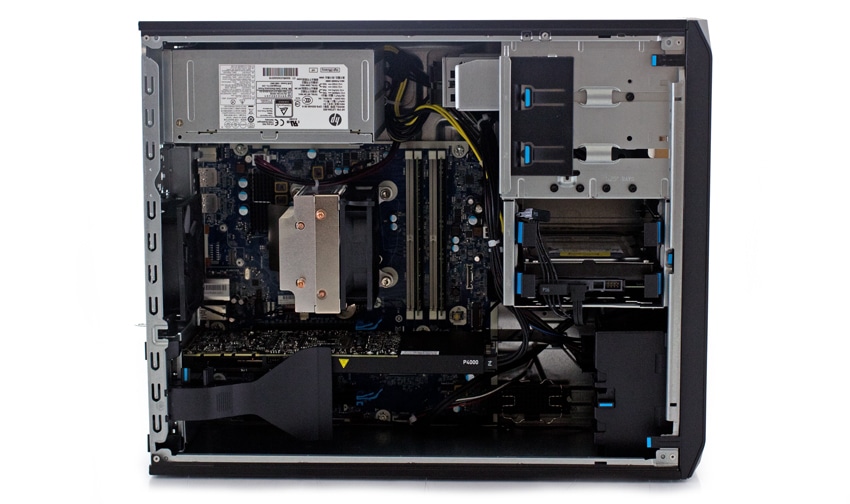
The HP Z2 Tower G4 workstation is the next generation up from the Z240. HP is targeting the Z2 at entry and mid-range creators needs in AEC/Product Dev (e.g., CAD), Higher Education (e.g., Engineering labs), as well as Media and Entertainment (e.g., Maya). It is 13% smaller but with options for graphics packages providing 60% more power than the Z240.

Like many HP and other off the shelf workstations, the Z2 offers several customization options. For processors, it leans towards 8th generation Intel processors but also supports several Xeon processors and even a Pentium. Notably, many of the CPU options boast six cores, a major plus for anyone doing multi-threaded work. The Z2 also offers a range of hard drives depending on your storage and access speed needs, including their HP Z Turbo Drive G2 PCIe NVMe SSD. The NVMe drives provide some pretty significant performance gains over standard high-performing SSDs. This includes faster boot up, calculation, and graphics response times. It also allows for ideal work conditions under resource-heavy applications, adding a ton of versatility and power to the Z2.
Up front, there's a headphone/microphone combo port for easy access. In addition to the headphone port. Between them, they should cover all of your in-office audio output needs to help drown out distractions. The front ports are rounded out by 2 USB 3.0 ports, but only 1 of them provides charging. There's also the option of adding 1 USB 3.1 Gen 2 Type-Cport. It is nice to see support for Type-C ports spreading. In back there are four more USB 3.0 ports in most models as well as several other ports including a DVI-I single link and 2 DisplayPort1.2s.
HP Z2 Tower G4 Specifications
| Form Factor | Tower |
| Operating System | Windows 10 Pro for Workstations 64 Windows 10 Home 64 Windows 10 Pro (National Academic only) |
| Processor Family | Intel Xeon processor (E-2176G, E-2174G, E-2146G, E-2144G, E-2136, E-2126G, E-2124G, E-2104G) Intel Pentium Gold processor; 8th Generation Intel Corei7+ processor 8th Generation Intel Corei7 processor 8th Generation Intel Corei5+ processor 8th Generation Intel Corei5 processor 8th Generation Intel Corei3 processor |
| Chipset | Intel C246 |
| Maximum Memory | 64 GB DDR4-2666 ECC SDRAM 64 GB DDR4-2666 non-ECC SDRAM |
| Memory Slots | 4 DIMM |
| Drive Controllers | Integrated SATA (4 ports 6 Gb/s) with integrated RAID 0, 1, for PCIe SSDs supported |
| Internal Storage | 500 GB up to 6 TB 7200 rpm SATA 500 GB SATA SED 256 GB up to 2 TB SATA SSD 280 GB up to 480 GB Intel OptaneSSD 905P (available Fall 2018) 256 GB up to 512 GB SATA SED SSD 256 GB up to 1 TB HP Z Turbo Drive G2 PCIe NVMeSSD |
| Optional Optical Storage | HP Slim Blu-ray Writer HP Slim DVD-ROM HP Slim DVD-Writer |
| Available Graphics | Integrated: Intel UHD Graphics 630 Intel UHD Graphics P630 10,11 Entry 3D: AMD RadeonPro WX 3100 Graphics (4 GB GDDR5 dedicated) AMD RadeonPro WX 7100 Graphics (8 GB GDDR5 dedicated) NVIDIA Quadro P1000 (4 GB GDDR5 dedicated) NVIDIA Quadro P2000 (5 GB GDDR5 dedicated) NVIDIA Quadro P400 (2 GB GDDR5 dedicated) NVIDIA Quadro P5000 (16 GB GDDR5X dedicated) NVIDIA Quadro P620 (2 GB GDDR5 dedicated) NVIDIA Quadro P4000 (16 GB GDDR5 dedicated) |
| Networking | |
| LAN | Integrated Intel I219-LM PCIe GbE (Optional or add-on feature) Intel I350-T2 dual-port GbE NIC |
| WLAN | Intel Dual Band Wireless-AC 9560 802.11a/b/g/n/ (2×2) Wi-Fi and Bluetooth 5 Combo |
| Expansion Slots | 2 M.2 PCIe 3 x4 1 PCIe Gen 3 x16 2 PCIe 3 x1 (x4 open ended connector) 2 PCIe 3 x4 (x16 connector) |
| Ports and Connectors | |
| Front | 1 headphone/microphone combo 2 USB 3.0 (1 charging) (Optional or add-on feature) 1 USB 3.1 Gen 2 Type-C |
| Rear | 1 audio-in 1 audio-out 1 DVI-I single link 1 RJ-45 2 DisplayPort1.2 2 USB 2.0 4 USB 3.0 (3 DisplayPort 1.2 in Performance model ) |
| Internal | 1 USB 3.0 2 USB 2.0 |
| Drive Bays | |
| Internal | Two 3.5" Two M.2 NVME 2280 SSD |
| External | Two 5.25" |
| Power | 500 W external power adapter, up to 90% efficiency, active PFC 250 W external power adapter, up to 85% efficiency, active PFC |
| Dimensions (WxDxH) | 14 x 6.7 x 17.1 in ( 35.6 x 16.9 x 43.5 cm ) |
| Weight | Starting at 15.43 lb ( 7 kg ) |
| Warranty | HP global standard limited warranty of 3 years parts, labor and on-site service |
Design and build
The front comes with a removable dust cover. After blocking off space for the optical drive bays, the Z2 still has over 50% of its front surface area devoted to facilitating airflow and thus cooling. Not bad, especially considering the smaller surface area compared to its predecessor. Like most of the other Z models, the corners are chiseled which makes them ever so slightly less painful to prop up with a foot while plugging cables in or when you inevitably bump into it during installation.
Flipping the Z2 around to take a look at the rear we can see how HP went all out to cut down the size. The only parts of the rear that provide airflow have fans backed up right against them. The top is for the power supply of course. The other one is aligned with the cooling tower for the CPU. Also seen here is the flexible rear I/O port which HP allows the customer to choose one of several options for as listed in the specifications above.
Removing the side panel, we can see the tightly packed interior. Despite the restricted space, the cables were still tucked away neatly for the most part. Our review model came with a NVIDIA Quadro P4000 Graphics as well as two 16gb memory sticks as you can see here. You can also see the two unused memory slots. Clustered at the bottom and largely hidden by the graphics card and the tab are additional PCIe ports.
NVIDIA Quadro P4000 Specifications
- GPU Memory: 8GB GDDR5
- Memory Interface: 256-bit
- Memory Bandwidth: Up to 243 GB/s
- NVIDIA CUDA Cores: 1792
- System Interface: PCI Express 3.0 x16
- Max Power Consumption: 105 W
- Thermal Solution
- Active Form Factor: 4.4” H x 9.5” L, Single Slot, Full Height
- Display Connectors 4x DP 1.4
- Max Simultaneous Displays: 4 direct, 4 DP 1.4 Multi-Stream
- Display Resolution 4x 4096×2160 @ 120Hz 4x 5120×2880 @ 60Hz Graphics APIs Shader Model 5.1, OpenGL 4.54 , DirectX 12.05 , Vulkan 1.04
- Compute APIs: CUDA, DirectCompute, OpenCL
Performance
To test the HP Z2 Tower's performance in resource-intensive environments, we put the workstation through three specific benchmarks. These tests will also show how well the Quadro P4000 performs inside the Dell mobile workstation. We've also compared it to the following workstations:
This first benchmark used to test the Z2 is the SPECviewperf 12 benchmark, which is the worldwide standard for measuring graphics performance based on professional applications. SPECviewperf runs 9 benchmarks called “viewsets.” These represent graphics content and behavior from actual applications and include categories such as 3D Max, CATIA, Creo, Energy, Maya, Medical, Showcase, Siemens NX, and Solidworks.
| SPECviewperf 12 | ||||
|---|---|---|---|---|
| Viewsets | HP Z2 G4 (P4000) | HP Z2 Mini (M620) | HP z640 (M5000) | HP z640 (M2000) |
| 3dsmax-05 | 136.71 | N/A | N/A | N/A |
| catia-04 | 154.66 | 34.38 | 129.82 | 69.36 |
| creo-01 | 131.17 | 36.99 | 97.00 | 62.82 |
| energy-01 | 12.74 | 0.64 | 9.72 | 4.07 |
| maya-04 | 124.62 | 30.02 | 83.68 | 49.88 |
| medical-01 | 55.34 | 10.82 | 43.38 | 19.21 |
| showcase-01 | 70.74 | 20.40 | 66.68 | 28.45 |
| snx-02 | 157.21 | 28.60 | 118.16 | 61.94 |
| sw-03 | 177.55 | 58.56 | 129.69 | 91.01 |
In the SPECviewperf test the HP Z2 Tower G4 had impressive results across the board beating out the more powerful HP Z640 equipped with either GPU. The results were 136.71 in 3D Max (the test was not available at the time the other workstations were tested, 154.66 for CATIA, 131.17 in Creo, 12.74 in Energy, 124.62 in Maya, 55.34 in Medical, 70.74 in Showcase, 157.21 in Siemens NX, and 177.55 in Solidworks.
Next up is our SPECwpc test. This benchmark is designed for gauging all of key aspects of workstation performance and consists of over 30 workloads related to CPU, graphics, I/O, and memory bandwidth. The workloads fall under broader categories, such as media and entertainment, financial services, product development, energy, life sciences, and general operations, which are an average of all the individual workloads in each category. The HP Z2 G4 showed the following results when equipped with a Quadro P4000.
| SPECwpc v2.0 | ||||
|---|---|---|---|---|
| Category | HP Z2 G4 (P4000) | HP Z2 Mini (M620) | HP z640 (M5000) | HP z640 (M2000) |
| M&E | 2.84 | 2.37 | 4.34 | 3.93 |
| ProdDev | 2.57 | 2.21 | 4.3 | 3.83 |
| LifeSci | 2.68 | 2.29 | 5.58 | 4.75 |
| Energy | 2.71 | 1.79 | 6.14 | 5.49 |
| FSI | 3.62 | 1.29 | 0 | 4.82 |
| GeneralOps | 1.13 | 1.36 | 1.49 | 1.5 |
For SPECwpc the new Z2 Tower was able to easily outperform the mini version but trailed behind the more powerful desktops.
Using our ESRI benchmark, we look at several aspects of the ArcGIS program; however, we are most interested in the average of the drawtime, average frames per second (Average FPS), and minimum frames per second (Minimum FPS). Looking at drawtime, the HP Z2 tower G4 showed an average time of 0:06.372, while average and minimum FPS recorded a solid 494.04 and 259.09, respectively.
| ESRI Benchmark | |
|---|---|
| Drawtime | Average |
| HP Z2 G4 (P4000) | 0:00:06.372 |
| HP Z2 Mini (M620) | 0:00:04.929 |
| HP z640 (M5000) | 0:00:06.324 |
| HP z640 (M2000) | 0:00:06.262 |
| Average FPS | Average |
| HP Z2 G4 (P4000) | 494.04 |
| HP Z2 Mini (M620) | 179.39 |
| HP z640 (M5000) | 286.87 |
| HP z640 (M2000) | 273.51 |
| Minimum FPS | Average |
| HP Z2 G4 (P4000) | 259.09 |
| HP Z2 Mini (M620) | 97.58 |
| HP z640 (M5000) | 112.13 |
| HP z640 (M2000) | 160.51 |
Conclusion
The HP Z2 G4 workstation is an entirely adequate entry-level desktop workstation. Noticeably smaller than its predecessor, it still manages to offer significant customization options that can boost its performance to the next level including support for full-size add in cards. Users can equip the workstation with 8th generation Intel Core processors, up to 64GB of DDR4 memory, and multiple storage options form SATA to NVMe depending on storage performance needs. Also depending on needs, the Z2 G4 can be outfitted with a slew of GPU options form Intel to AMD Radeon Pro to NVIDIA Quadro.
Though it is an entry-level workstation, the HP Z2 G4 had some impressive performance, particularly in our SPECviewperf where it outperformed the much more powerful Z640 across the board. In the less graphics intense but more overall check of performance in the SPECwpc the Z2 G4 was able to out perform the mini but unsurprisingly couldn’t keep up with the larger more powerful Z640. In our ESRI benchmark the Z2 G4 had an average drawtime of 6.372 seconds but it really shined in average FPS at 94.04 and Minimum FOS at 259.09 on average for both.
Being an entry-level workstation, the HP Z2 Tower G4 can still bring some impressive performance as well as lots of customizations in order to fit into several use cases.
Sign up for the StorageReview newsletter


